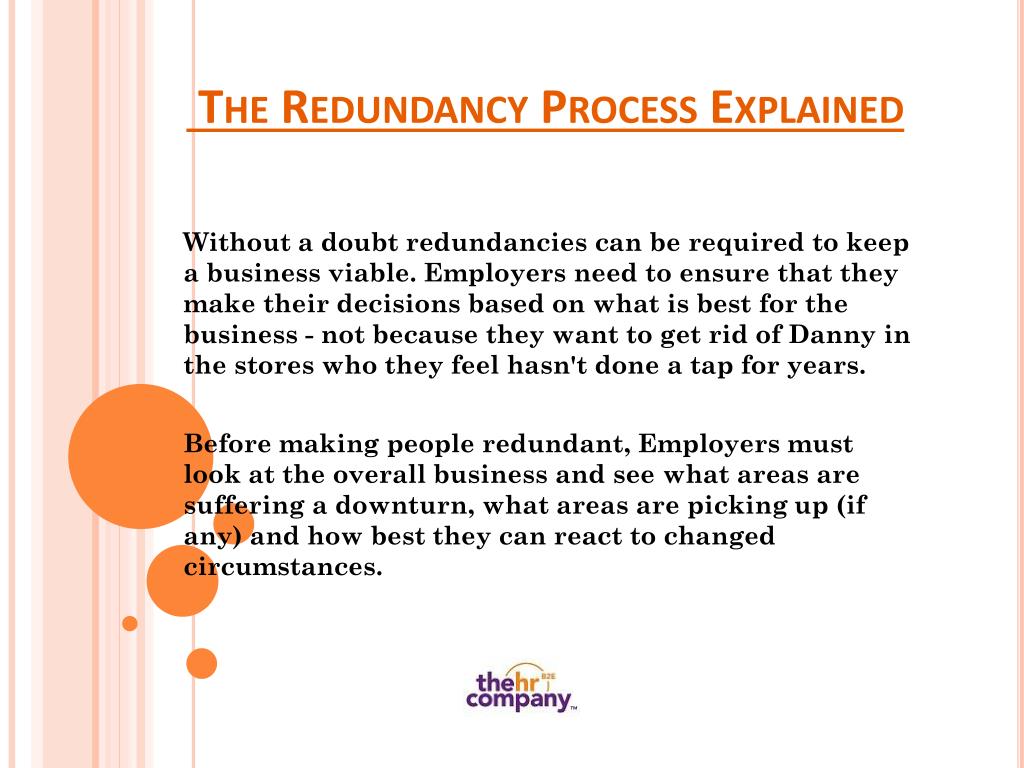Redundancy Pay If Company Goes Bust: Recognizing Your Entitlements in the UK
Redundancy Pay If Company Goes Bust: Recognizing Your Entitlements in the UK
Blog Article
Examining the Interplay In Between Firm Redundancy and Business Versatility for Future Growth
In the dynamic landscape of today's business globe, the intricate relationship in between company redundancy and business flexibility emerges as a crucial variable for continual growth and success. Companies typically face the challenge of striking a fragile equilibrium in between preserving a level of redundancy to mitigate risks and cultivating adaptability to respond promptly to the ever-evolving market demands.
Significance of Business Redundancy
Firm redundancy is an important aspect that boosts business durability and minimizes functional risks. By incorporating redundancy measures within the business structure, companies can better withstand unpredicted interruptions and fluctuations in the business environment. Redundancy functions as a strategic barrier, permitting firms to adapt and react efficiently to unexpected difficulties without compromising vital operations.
One key aspect of the relevance of firm redundancy is its function in making sure connection during times of situation. When faced with abrupt modifications or emergency situations, redundant systems, sources, or employees can step in to preserve critical features and avoid prevalent interruptions. This continuity not just safeguards the business's reputation and customer depend on yet likewise decreases monetary losses and operational downtime.

Techniques for Business Flexibility

Producing adaptable organizational frameworks that allow for quick adjustments to market characteristics and consumer requirements is important for staying affordable in a swiftly developing setting. By proactively identifying possible disruptions and possibilities, organizations can proactively adapt and flourish in an ever-changing organization landscape.
Harmonizing Redundancy and Flexibility
Achieving an unified stability between operational redundancy and organizational adaptability is paramount in browsing the complexities of a dynamic organization environment. Striking the best equilibrium in between redundancy and versatility is a fragile process that requires a deep understanding of the organization's goals, sector dynamics, and threat resistance.
To accomplish this balance, companies need to conduct routine analyses of their operations to identify locations where redundancy is necessary for risk mitigation and where flexibility can drive innovation and growth. Implementing versatile frameworks, cultivating a culture of constant understanding and improvement, and motivating open interaction throughout all degrees of the company are crucial methods to balance redundancy and adaptability efficiently. By aligning these 2 essential components, business can position themselves for sustainable growth and success in an ever-changing business landscape.
Study on Adjustment Success
In checking out instances of effective organizational adjustment, it comes to be apparent that the interplay in between operational redundancy and adaptability is a specifying consider shaping resilient organizations. One compelling case research is that of Netflix. At first a DVD rental service, Netflix showed impressive flexibility by transitioning into a streaming system when digitalization disrupted the sector. By tactically buying modern technology and content production, Netflix not only flourished yet made it through in a rapidly progressing market. Another standout instance is Amazon. Starting as an on the internet advice bookstore, Amazon constantly adjusted its company version, expanding right into varied fields such as cloud computer and fabricated intelligence. This versatility permitted Amazon to remain in advance of competitors and satisfy altering customer needs. Last but not least, Adobe supplies a notable illustration of effective adjustment. The firm moved from marketing software licenses to a subscription-based design, making certain repeating earnings streams and improved customer interaction. These instance studies highlight the relevance of functional redundancy coupled with organizational versatility in cultivating lasting growth and competitiveness.
Structure Durability for Future Growth
Building resilience for future development calls for a tactical alignment of functional processes with market characteristics and emerging trends. Firms need to adapt to altering settings by promoting a culture of versatility, innovation, and constant enhancement.
Furthermore, fostering strong connections with stakeholders, such as customers, workers, vendors, and the neighborhood, is necessary for weathering unpredictabilities and preserving count on and support throughout unstable times. Reliable interaction and transparency play an essential function in structure resilience, as they assist promote and align assumptions collaboration in navigating unpredictabilities.
Furthermore, organizations require to focus on learning and development efforts to upskill staff members and equip them with the required tools to adjust to changing scenarios. By purchasing their labor force, companies can enhance their versatility and dexterity, inevitably reinforcing their strength for lasting future growth.
Conclusion

In the dynamic landscape of today's service world, the elaborate partnership between business redundancy and business adaptability emerges as a crucial element for continual development and success. Firms typically encounter the challenge of striking a delicate equilibrium in between maintaining a level of redundancy to alleviate threats and fostering versatility to react promptly to the ever-evolving market needs.To achieve this equilibrium, firms need to conduct routine evaluations of their procedures to recognize areas where redundancy is required for danger reduction and where flexibility can drive innovation and growth.In conclusion, why not look here the interplay between firm redundancy and organizational versatility is vital for future development. Structure strength through a combination of redundancy and click to read more adaptability will guarantee that companies are prepared for the difficulties of the future.
Report this page